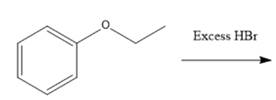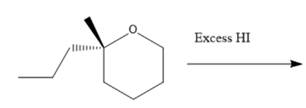
Concept explainers
(a)
Interpretation: The major product formed in the given reaction needs to be identified.

Concept Introduction: To solve the given problem, reactions shown by ethers need to be studied in detail. Generally, ether does not react under mildly acidic or basic conditions. Because of this, they are used as a solvent in many reactions. Ethers can show an acidic cleavage reaction when heated in the presence of excess HX. This process involves two substitution reactions.
(b)
Interpretation: The major product formed in the given reaction needs to be identified.

Concept Introduction: To solve the given problem, reactions shown by ethers need to be studied in detail. Generally, ether does not react under mildly acidic or basic conditions. Because of this, they are used as a solvent in many reactions. Ethers can show an acidic cleavage reaction when heated in the presence of excess HX. This process involves two substitution reactions.
(c)
Interpretation: The major product formed in the given reaction needs to be identified.

Concept Introduction: To solve the given problem, reactions shown by ethers need to be studied in detail. Generally, ether does not react under mildly acidic or basic conditions. Because of this, they are used as a solvent in many reactions. Ethers can show an acidic cleavage reaction when heated in the presence of excess HX. This process involves two substitution reactions.
(d)
Interpretation: The major product formed in the given reaction needs to be identified.

Concept Introduction: To solve the given problem, reactions shown by ethers need to be studied in detail. Generally, ether does not react under mildly acidic or basic conditions. Because of this, they are used as a solvent in many reactions. Ethers can show an acidic cleavage reaction when heated in the presence of excess HX. This process involves two substitution reactions.
(e)
Interpretation: The major product formed in the given reaction needs to be identified.

Concept Introduction: To solve the given problem, reactions shown by ethers need to be studied in detail. Generally, ether does not react under mildly acidic or basic conditions. Because of this, they are used as a solvent in many reactions. Ethers can show an acidic cleavage reaction when heated in the presence of excess HX. This process involves two substitution reactions.
(f)
Interpretation: The major product formed in the given reaction needs to be identified.

Concept Introduction: To solve the given problem, reactions shown by ethers need to be studied in detail. Generally, ether does not react under mildly acidic or basic conditions. Because of this, they are used as a solvent in many reactions. Ethers can show an acidic cleavage reaction when heated in the presence of excess HX. This process involves two substitution reactions.
Want to see the full answer?
Check out a sample textbook solution
Chapter 13 Solutions
ORGANIC CHEMISTRY- NEXTGEN PACKAGE
- Predict the product(s) and provide the mechanism for each reaction below.arrow_forwardGive me a clear handwritten Detailed Solutionarrow_forwardPredict all possible products for the following reactions: please clearly show MAJOR product, MINOR product, and TRACE product (if it is possible theoretically but not expected to be observed). If no products are expected, please say NO REACTION: ? O₂N A NO₂ NO₂ HNO3 NO₂ H₂SO4 B NO₂ NO₂ O₂N C NO₂ D NO REACTIONarrow_forward
- Predict the major products of the following reaction. If it is possible, write all stereoisomers.arrow_forwardGive the major products for the following reactionarrow_forwardWhich of the compounds below is the major product of the following reaction? (1) Hg(OAc)/ H2O/THF (2) NaBD/ethanol OH он OH - OH Compound A Compound B Compound C Compound D O Compound B O Compound C OCompound A Compound Darrow_forward
- 4) Predict the major product(s) for the following reactions (a) (b) HO OH uogicH₂SO4ollbl NH₂ COOK H3O+ 1970arrow_forwardElimination, stereochemical aspects. Draw the major product that is obtained when (2R,3R)-2-Bromo-3-phenylbutane is treated with sodium ethoxide and explain the stereochemical outcome of the reaction using Newman projections.arrow_forwardProvide the products for the reactions, including the appropriate stereochemistry. 1) O3 i) 2) DMS H2 ii) Pdarrow_forward
- Predict the products for each of the following reactions and provide an explanation for the stereochemistry of the product. NC !! -CNarrow_forwardWhat is the expected major product of the following reaction? Include appropriate stereochemistry, where applicable. 1) DCC HOBt N OH 2) H₂N- CH3 OCH 3arrow_forwardWhat is the expected major product of the following reaction? Include appropriate stereochemistry, where applicable. NN Ⓒ = + f восх Q₂ NaOH H₂O heat JOH N H 10 P Brarrow_forward

 Organic ChemistryChemistryISBN:9781305580350Author:William H. Brown, Brent L. Iverson, Eric Anslyn, Christopher S. FootePublisher:Cengage Learning
Organic ChemistryChemistryISBN:9781305580350Author:William H. Brown, Brent L. Iverson, Eric Anslyn, Christopher S. FootePublisher:Cengage Learning

